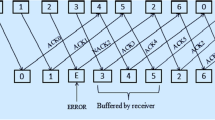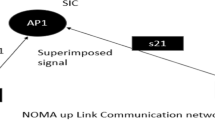Abstract
Due to the volatile characteristics of wireless channel and limited battery resource in the handheld devices, high throughput and energy efficiency are important criteria for the design of mobile communication protocols. This paper proposes an energy efficient error control scheme, which has on-demand quality of services for wireless data networks. This scheme can be utilized to accomplish the dual goals of reducing energy consumption and preserving quality of service over wireless links. It combines a simple power control scheme with a hybrid automatic repeat request strategy using rate-compatible punctured convolutional codes. In order to increase the system utility, the power and the coding rate for the data transmission are adjusted to match the channel variation. In case of frame error rate being constrained, such as 10−6, thethroughput and utility are analysed and it is found that the proposed scheme outperforms the existing schemes that use only error control.
Similar content being viewed by others
References
C.E. Jones, K.M. Sivalingam, P. Agrawal and J.C. Chen, “A Survey of Energy Efficient Network Protocols for Wireless Networks”, Wireless Networks, Vol. 7, pp. 343-358, 2001.
M. Zorzi and R.R. Rao, “Error Control and Energy Consumption in Communications for Nomadic Computing”, IEEE Trans. Comp., Vol. 46, No. 3, pp. 279-289, 1997.
J.P. Ebert and A. Wolisz, “Combined Tuning of RF Power and Medium Access Control for WLANs”, Mobile Networks and Applications, Vol. 6, pp. 417-426, 2001.
Z. Sun, S. Kimura and Y. Ebihara, “A Study on Hybrid ARQ Scheme for WATM”, in Proc. YRP Telecom Summit, 2000, pp. 71-72.
Y. Lu and R. Brodersen, “Unified Power Control, Error Correction Coding and Scheduling for a CDMA Downlink System”, in Proc. INFOCOM, 1996, pp. 1125-1132.
S. Lin, D.J. Costello, Jr. and M.J. Miller, “Automatic-Repeat-Request Error-Control Schemes”, IEEE Commun. Mag., Vol. 22, No. 12, pp. 5-17, 1984.
Third Generation Partnership Project, Technical Specification Group, “Radio Access Network”, Working Group 1, Multiplexing and Channel Coding (FDD).
D.J. Costello, J. Hagenauer, H. Imai and S.B. Wicker, “Applications of Error-Control Coding”, IEEE Trans. Infor. Theory, Vol. 44, No. 6, pp. 2531-2560, 1998.
J. Hagenauer, “Rate-Compatible Punctured Convolutional Codes (RCPC Codes) and their Applications”, IEEE Trans. on Commun., Vol. 36, No. 4, pp. 389-400, 1988.
John G. Proakis, Digital Communication, 3rd edn, McGraw-Hill, 1995.
D. Goodman and N. Mandayam, “Power Control forWireless Data”, IEEE Personal Commun., Vol. 7, No. 2, pp. 48-54, 2000.
D. Famolari, N. Mandayam, D. Goodman and V. Shah, “A New Framework for Power Control in Wireless Data Networks: Games, Utility and Pricing”, Wireless Multimedia Network Technologies, Kluwer Academic Publishers, pp. 289-310, 1999.
V. Rodoplu and T.H. Meng, “Minimum Energy Mobile Wireless Networks”, IEEE Journal on Selected Areas in Commun., Vol. 17, No. 8, pp. 1333-1344, 1999.
Author information
Authors and Affiliations
Rights and permissions
About this article
Cite this article
Sun, Z., Jia, X. Energy Efficient Hybrid ARQ Scheme under Error Constraints. Wireless Personal Communications 25, 307–320 (2003). https://doi.org/10.1023/A:1024460529437
Issue Date:
DOI: https://doi.org/10.1023/A:1024460529437




